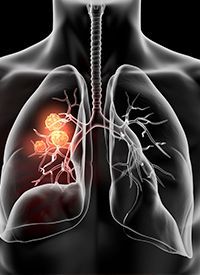Article
Furmonertinib Plus Icotinib Elicits Antitumor Activity in EGFR+ NSCLC With CNS Metastases
Author(s):
First-line treatment with furmonertinib plus icotinib induced responses in patients with EGFR-mutant non–small cell lung cancer. including those with central nervous system metastases, according to data from an ongoing phase 2 trial.
Image Credit: © Axel Kock - stock.adobe.com

First-line treatment with furmonertinib (AST2818) plus icotinib (Conmana) induced responses in patients with EGFR-mutant non–small cell lung cancer (NSCLC), including those with central nervous system (CNS) metastases, according to data from an ongoing phase 2 trial (ChiCTR2200060151) presented at the 2023 European Lung Cancer Congress.1
At a data cutoff of November 30, 2022, and with a median follow-up of 230 days, the median investigator-assessed progression-free survival (PFS) was not yet reached in those who received the doublet (n = 18). Moreover, the confirmed objective response rate (ORR) was 88.9%, with all 16 responders experiencing a partial response; the disease control rate (DCR) was 100%. All patients achieved tumor shrinkage, with a median best percentage change of –34.4% (range, –76.1% to –27.1%).
Notably, in the 15 patients with CNS metastases at baseline, the ORR with the combination was 86.7%, and the DCR was 100%.
“This study is ongoing, and more results will be evaluated in the future, which may help elucidate a role of dual EGFR TKI therapy in the first-line setting,” lead study author Hualin Chen, MS, of the Department of Pulmonary Oncology at Affiliated Hospital of Guangdong Medical University in Zhanjiang, China, and colleagues, wrote in a poster presentation of the data.
Previous data from the phase 3 FURLONG trial (NCT03787992) indicated that the highly brain-penetrant pan-EGFR TKI furmonertinib demonstrated an improvement in PFS over gefitinib (Iressa), at 20.8 months (95% CI, 17.8-23.5) and 11.1 months (95% CI, 9.7-12.5), respectively, in patients with EGFR-mutant NSCLC (HR, 0.44; 95% CI, 0.34-0.58; P < .0001).2
Additionally, results from a phase 2b trial (NCT03452592) showed that acquired EGFR C797X mutations were the most common resistance mechanisms to treatment with furmonertinib.3 Investigators hypothesized that the first-generation TKI icotinib may overcome furmonertinib resistance due to EGFR C797S mutations, and that dual EGFR inhibition with first- and third-generation inhibitors may delay the onset of acquired resistance.4
The ongoing, single-arm, open-label phase 2 trial is being conducted at the Affiliated Hospital of Guangdong Medical University and is exploring the combination of furmonertinib and icotinib in the first-line setting for patients at least 18 years of age with histologically or cytologically confirmed, locally advanced or metastatic NSCLC harboring EGFR exon 19 deletions, L858R mutations, or exon 20 insertion mutations.
To be eligible for enrollment, patients are required to have at least 1 measurable lesion per RECIST v1.1 criteria. Patients with asymptomatic, stable CNS metastases that do not require steroids at least 4 weeks before the first dose of study treatment are also allowed to enroll.
The study has a planned enrollment of 40 patients. Eighteen participants received oral furmonertinib at 80 mg once daily and oral icotinib at 125 mg 3 times per day. Treatment continued until intolerable toxicity or disease progression.
Investigator-assessed PFS is serving as the primary end point of the trial. Secondary end points include ORR, DCR, overall survival, and safety.
The median age of those enrolled and treated prior to the data cutoff was 61.5 years (range, 43-82). Additionally, 55.6% of patients were female, and 27.8% had a smoking history. ECOG performance status ranged from 1 (88.9%) to 2 (11.1%). EGFR mutational status included exon 19 deletion (55.6%), L858R (38.9%), and exon 20 insertion (5.6%). Furthermore, 83.3% of patients had CNS metastases. The majority of patients had stage IV disease (94.4%), and one patient had stage III disease.
Regarding safety, treatment-emergent adverse effects (TEAEs) of any grade were observed in 100% of patients. The most common any-grade TEAEs reported in at least 20% of patients included diarrhea (27.8%), elevated aspartate aminotransferase (27.8%), elevated alanine aminotransferase (22.2%), and rash (22.2%). The only grade 3 TEAE reported was diarrhea, which resulted in a 7-day treatment interruption; thereafter, the patient continued treatment with furmonertinib at 80 mg.
No patients experienced dose reductions or treatment discontinuation due to TEAEs.
References
- Chen H, Lin M, Jiang J, et al. Furmonertinib plus icotinib for first-line treatment of EGFR-mutated non-small cell lung cancer. Presented at: 2023 European Lung Cancer Congress; March 29-April 1, 2023; Copenhagen, Denmark. Poster 25P.
- Shi Y, Chen G, Wang X, et al. Furmonertinib (AST2818) versus gefitinib as first-line therapy for Chinese patients with locally advanced or metastatic EGFR mutation-positive non-small-cell lung cancer (FURLONG): a multicentre, double-blind, randomised phase 3 study. Lancet Respir Med. 2022;10(11):1019-1028. doi:10.1016/S2213-2600(22)00168-0
- Shi Y, Hu X, Zhang S, et al. Efficacy, safety, and genetic analysis of furmonertinib (AST2818) in patients with EGFR T790M mutated non-small-cell lung cancer: a phase 2b, multicentre, single-arm, open-label study. Lancet Respir Med. 2021;9(8):829-839. doi:10.1016/S2213-2600(20)30455-0
- Rotow JK, Botelho Costa D, Paweletz CP, et al. Concurrent osimertinib plus gefitinib for first-line treatment of EGFR-mutated non-small cell lung cancer (NSCLC). J Clin Oncol. 2020;33(suppl 15):9507. doi:10.1200/JCO.2020.38.15_suppl.9507








